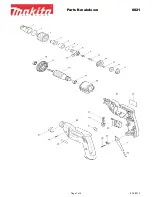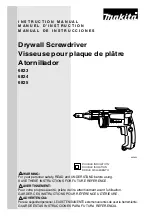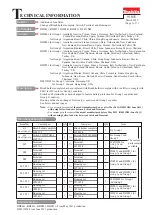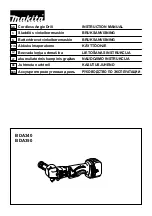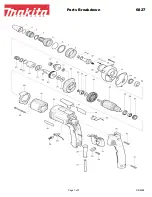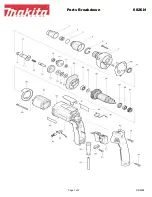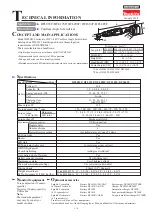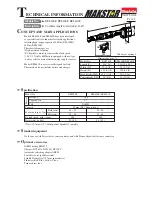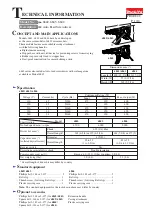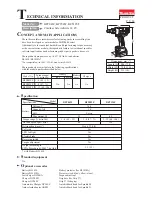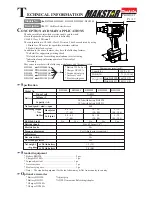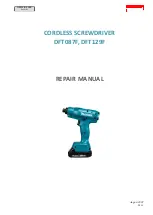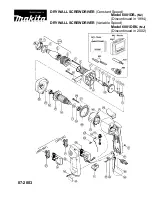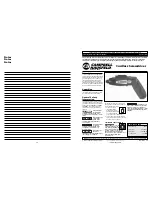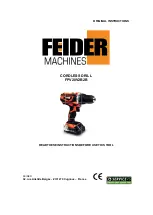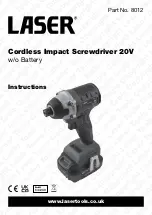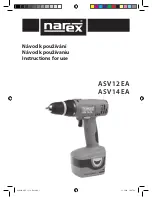
Before Use
Charging the battery
• The battery should be charged at 20˚C (room temperature)
1. Insert the Charger DC plug (10) into the DC Charging Socket (5)
2. Plug the Charger (9) into a mains socket. The Charging LED (3) will illuminate to indicate the
power tool is charging
3. After 3-5 hours the battery will be fully charged and should be disconnected from the
power supply
4. Allow the battery to cool for 15 minutes after charging
5. Disconnect the Charger from the power supply and store in a clean, dry environment out of the
reach of children
IMPORTANT:
The charging process does not switch off automatically. Charging must be switched off
manually after 3 hours and before 5 hours. Charging for more than 5 hours can damage the battery.
Use a plug-in timer, set to 4 hours to avoid over-charging the battery, if there is a risk of forgetting to
to switch off the charger.
IMPORTANT
: Ni-Cd batteries lose charge quickly. Charge the tool on the same day or on the day
before use to ensure the longest possible operation time.
WARNING:
Failure to follow the correct procedure when charging the battery will result in permanent
damage. You must follow the correct procedure.
Operation
Note:
You can fit 50mm length ¼” (6.35mm) hex-type screwdriver bits directly into the Bit Holder (7),
or use an extension bit holder (not supplied) for compatibility with shorter 25mm screwdriver bits.
1. If required, change the position of the Handle (4) by pushing the Handle Rotation Switch (1)
forward and then turning the Handle to the required position. The Handle will rotate at the
Handle Rotation Point (2) to two possible positions
Avant utilisation
Charge de la batterie
• La batterie doit être chargée à 20° (température ambiante)
1. Branchez la fiche CC du chargeur (10) sur la prise CC du chargeur (5)
2. Branchez le chargeur (9) sur une prise secteur. Le témoin LED de charge (3) s’allume pour
indiquer que l’appareil se charge.
3. Une fois la batterie complètement chargée après 3-5 heures, débranchez le chargeur de
l’alimentation secteur.
4. Laissez la batterie refroidir pendant 15 minuntes après la charge
5. Débranchez le chargeur de l’appareil et rangez-le dans un endroit propre, sec et hors de
portée des enfants.
Important :
La charge ne s’arrête pas automatiquement. Il est donc important d’arrêter la charge
manuellement après les 3-5 heures. Charger pour plus de 5 heures peut endommager la batterie.
Pour ne pas oublier de débrancher le chargeur, utilisez une prise minuterie, programmée sur 4
heures afin d’éviter une surcharge de la batterie.
Important :
Les batteries Ni-Cd perdent rapidement la charge. Chargez la batterie le même jour ou
le jour avant l’utilisation pour s’assurer d’une plus longue durée d’utilisation.
ATTENTION :
Ne pas respecter ces consignes pour charger la batterie peut engendrer des
dommages irréversibles. Suivez la procédure correcte.
Instructions d’utilisation
Remarque :
Vous pouvez installez directement un embout de vissage 1/4” à six pans de 50 mm
sur le porte-embouts (7), ou utilisez un porte-embouts (non fourni) pour les embouts de vissage
plus courts de 25 mm.
1. Si nécessaire, changez la position de la poignée(4) en poussant le bouton de rotation de
la poignée (1) vers l’avant et tournez la poignez pour la mettre dans la position requise.
La poignée pivote sur le point de rotation (2) sur deux positions possibles.
Safety Information
WARNING:
DO NOT use the Charger outside or any environment where the charger will be exposed
to rain and moisture
WARNING:
DO NOT connect the Charger to a mains supply of different voltage or mains frequency
to the rating label on the Charger or stated in the specification.
Consignes de sécurité
ATTENTION :
N’utilisez pas le chargeur à l’extérieur ou dans un endroit exposé à la
pluie et à l’humidité.
ATTENTION
: Ne branchez pas le chargeur sur une source d’alimentation ayant une tension ou
une fréquence différente de celle de l’étiquette du chargeur, ou indiquées dans les
caractéristiques techniques.
3.6V Cordless Screwdriver
243592
c
d
3.6V Cordless Screwdriver
Visseuse sans fil 3,6 V
Akkuschrauber, 3,6 V
Atornillador inalámbrico 3,6 V
Cacciavite a batteria 3.6V
3,6 V accuschroevendraaier
www.silverlinetools.com
7
4
1
Specification
Screwdriver
Voltage:
3.6V
Battery Type:
Ni-Cd
Battery Capacity:
0.6Ah
Charging Time:
3-5hrs
Bit Holder:
¼
"
(6.35mm)
No Load Speed:
250min
-
¹
Maximum Torque:
2.5Nm
Weight: 0.25Kg
Weighted Vibration:
<2.5m/s
²
Sound Power L
WA
:
<70dB(A)
Charger
Input Power:
230-240V~ 50Hz, 5W
Output Power:
6V DC, 300mA
Ingress Protection:
IP20
Protection Class:
Caractérisques
techniques
Visseuse
Tension :
3,6 V
Type de batterie :
Ni-Cd
Capacité :
0,6 Ah
Temps de charge :
3 – 5 h
Porte-embouts :
1/4
"
(6,35 mm)
Vitesse à vide :
250 min
-
¹
Couple max. :
2,5 Nm
Poids :
0,25 kg
Vibration pondérée :
<2,5 m/s²
Puissance acoustique L
wa
:
<70 dB(A)
Chargeur
Tension d’entrée : 230 – 240 V~ 50 Hz, 5 W
Tension de sortie :
6 V CC, 300 mA
Indice de protection :
IP20
Classe de protection :
Product
Familiarisation
1) Handle Rotation Switch
2) Handle Rotation Point
3) Charging LED
4) Handle
5) DC Charging Socket
6) Direction Switch
7) Bit Holder
8) Mains Plug
9) Charger
10) Charger DC Plug
Se familiariser
avec le produit
1) Bouton de rotation
de la poignée
2) Point de rotation de
la poignée
3) Témoin LED de charge
4) Poignée
5) Prise CC du chargeur
6) Bouton de mise
en rotation
7) Porte-embouts
8) Prise principale
9) Chargeur
10) Fiche CC du chargeur
Included accessories:
3 screwdriver bits
Accessoires inclus :
3 embouts de vissage
2. Insert the screwdriver bit into the Bit Holder
3. Insert the tip of the screwdriver bit into the screw head you wish to insert or remove
4. Operate the tool forward or backwards to insert or remove screws by pressing the Direction
Switch (6) in the required direction
WARNING:
If the tool has inadequate torque to insert or remove screws release the Direction
Switch immediately and finish the operation with a standard screwdriver by hand to prevent
damaging the tool.
Maintenance
Note:
This tool has no user serviceable internal parts.
• Clean the body of your machine with a soft brush, or dry cloth
• Never use caustic agents to clean plastic parts. If dry cleaning is not sufficient, a mild detergent
on a damp cloth is recommended
Storage
• Store this tool carefully in a secure, dry place out of the reach of children
Disposal
IMPORTANT:
This tool features a captive Ni-Cd battery which should not be disposed of with the
power tool. Remove this battery before disposing of the tool by unscrewing the 3 screws of the
Handle (4) and cutting the wires that connect to the battery and removing. Dispose of the battery
according to national or regional regulations in your country.
Always adhere to national regulations when disposing of power tools that are no longer functional
and are not viable for repair.
• Do not dispose of power tools, or other waste electrical and electronic equipment (WEEE),
with household waste
• Contact your local waste disposal authority for information on the correct way to dispose of
power tools
2. Insérez l’embout de vissage sur le porte-embouts de la visseuse.
3. Insérez la pointe de l’embout dans la tête de la vis que vous voulez visser ou dévisser.
4. Pour visser ou dévisser, appuyez sur le bouton de mise en rotation (6) vers l’avant ou vers
l’arrière selon le sens de rotation voulu.
ATTENTION :
Si la visseuse ne fournit pas le couple approprié pour le vissage ou le dévissage,
relâchez immédiatement le bouton de mise en rotation , et terminez votre tâche avec un tournevis
standard manuel pour éviter d’endommager l’appareil.
Entretien
Remarque :
Cet appareil ne possède pas des pièces internes de rechange.
• Nettoyez le boitier de la machine avec un chiffon doux et humide.
• N’utilisez jamais d’agents caustiques sur les parties plastiques. Si un nettoyage sec ne suffit
pas, il est recommandé d’utiliser un détergent doux sur un chiffon humide.
Rangement
• Rangez cet outil dans un endroit sûr, sec et hors portée des enfants.
Recyclage
Important :
Cet appareil possède une batterie Ni-cd intégrée qui ne doit pas être recyclée avec
l’appareil. Retirez la batterie avant de recycler l’appareil en dévissant les 3 vis de la poignée
(4) et en coupant les fils branchés sur la batterie afin de pouvoir l’enlever. Recyclez la batterie
conformément auz régulations nationales ou régionales de votre pays.
Lorsque l’appareil n’est plus en état de fonctionner et qu’il n’est pas réparable, recyclez l’appareil
conformément aux régulations nationales.
• Ne jetez pas les outils électriques et autres équipements électriques ou électroniques
(DEEE) avec les ordures ménagères.
• Contactez les autorités locales compétentes en matière de gestion des déchets pour vous
informer de la procédure à suivre pour recycler les outils électriques.
6
9
10
8
3
2
5
243592_Z1MANPRO1.indd 1
28/11/2013 16:18




